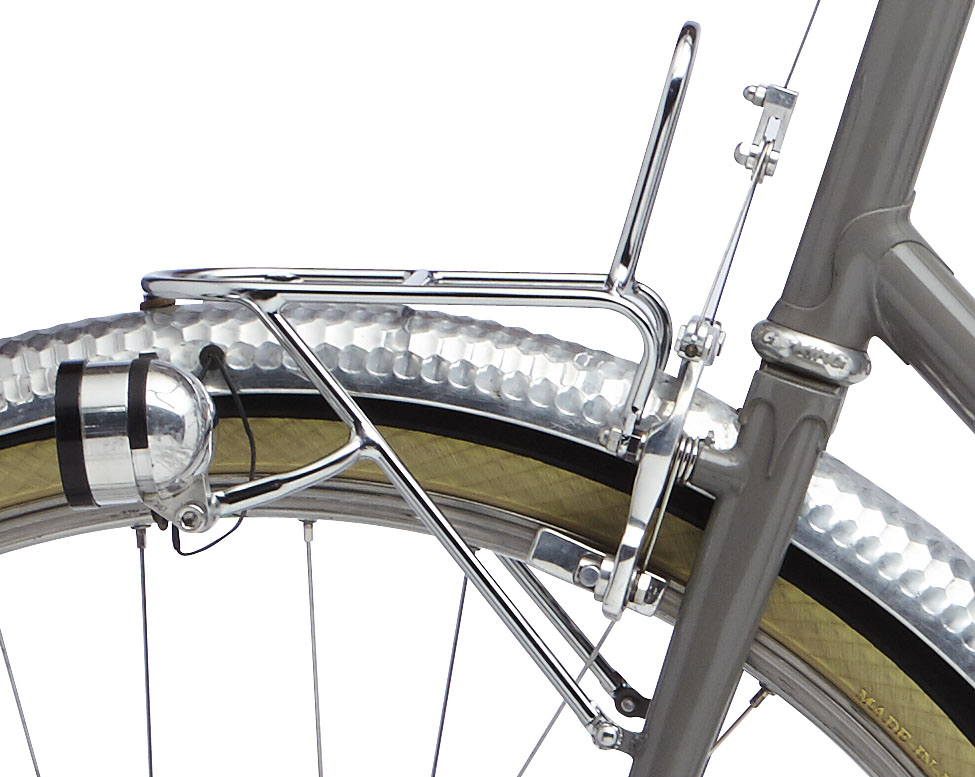Myths Debunked: Titanium is Lighter than Steel, but…

In part 2 of our series ‘Myths in Cycling,’ we’ll look at why titanium isn’t always lighter than steel. I can hear you saying, “What? Everybody knows that titanium has half the density of steel.”
That much is true: The same part made from titanium will weigh half as much as the equivalent from steel. But titanium has only half the stiffness, so the part will be half as stiff. To make the parts of the same stiffness, you need to use twice as much material with titanium, and the weight will be equal. The same applies to aluminum, which is one-third as heavy and one-third as stiff. (These numbers are for the high-strength alloys; raw aluminum, titanium and iron are not strong enough for cycling applications.)

For example, if you made a titanium rack, it would weigh the same as a steel rack with the same load capacity. That is why the best racks are made from steel: Other materials don’t offer any advantages.
So why do people use titanium at all? There are other considerations than stiffness. Frame tubes are a good example. The larger the diameter of a tube, the greater its stiffness-to-weight ratio. However, with steel tubes, you run into limits, because a frame tube cannot be made with walls much thinner than 0.4 mm. Otherwise, it becomes too easy to dent, and braze-ons will just rip out of the ultra-thin tube.
A way around that problem is to use titanium. With half the density of steel, if you double the wall thickness, you get a tube with the same stiffness and weight as a steel tube. But you don’t need the walls to be that thick, so you can use larger-diameter tubes. Many titanium frames are both a little lighter and a little more flexible than steel frames. Especially smaller frames can be too stiff for their riders, and using titanium can make for a better-performing frame.

The advantage of titanium frame tubes turns into a liability where you cannot increase the tubing diameter: at the chainstays. Chainstays have to fit the narrow space between the tire and the cranks. Because of this, making titanium chainstays as stiff as their steel equivalents is difficult, especially on a bike with wide tires.
My Firefly (above) uses super-beefy chainstays that probably contribute to its excellent performance, but as a result, standard road cranks don’t fit. The photo above shows it with its original CNC-machined cranks, which resulted in a wide Q factor and cross-chaining in the gears I use most. Since then, I installed forged Rene Herse cranks and filed the ends of the cranks, so I can use a shorter BB spindle. That improved the chainline and (almost) eliminated the cross-chaining. Now the Q factor is acceptable, too. Everything had to be optimized very carefully to make it work to my satisfaction, because it is such a tight fit.

Will a titanium frame provide superior performance for you? My Firefly (above) feels very similar to my steel bikes, and the small weight advantage of the frame is lost amongst other factors, such as the added weight of the disc brakes. I love the bike, but a similar one made from steel would perform similarly. It may be a different matter for small riders: Even a lightweight steel frame may be too stiff (small frames inherently are stiffer than larger ones). A carefully designed titanium frame may offer more flex in the right places and thus ‘plane’ better…

What about titanium bolts and other small parts? If you just replace a steel part, say a bolt or a bottom bracket spindle, with a titanium one, it’ll be far less strong. That is what Campagnolo found out when they introduced their Super Record bottom bracket – many of these broke. Of course, all parts have a margin of safety built in, and sometimes, you can reduce that margin without failure. A smoother-than-average rider probably can ride a titanium bottom bracket without failure.
The same applies to titanium bolts – if tightened carefully, they can work OK. But then you wonder why you don’t redesign the part with smaller steel bolts. They have the same strength, but go into a smaller hole, which allows you to make the mating part smaller, saving further weight… It’s one example where a well-designed part with steel bolts actually is lighter than one using titanium hardware.

There are a few places where titanium bolts make sense. The eyebolts that hold the brake pads of our brakes (upper bolt in the photo above) are large because the post of the brake pad needs to fit through the head. They don’t need to be this big to be strong enough. This means that a titanium eyebolt weighs half as much, yet has sufficient strength. And that is why we offer them as an option to reduce the weight of our brakes to just 75 g per wheel. That is lighter than any currently made brake, and yet we don’t give up any strength.
That eyebolt is an exception. Most bolts are dimensioned for the loads they need to withstand, like the bolt that attaches the brake to the pivot (lower bolt in the photo). We won’t offer a titanium version of that bolt because it might break, with disastrous consequences.

Conclusion
Titanium’s stiffness-to-weight ratio is the same as steel’s. Titanium’s density is lower, which can be an advantage when you need or want to make large parts (oversize frame tubes, eyebolts), or a disadvantage when space is limited (chainstays, bottom bracket spindles). Titanium’s lower density saves weight only in places where the dimensions of steel parts are constrained by other factors.
Further reading:



